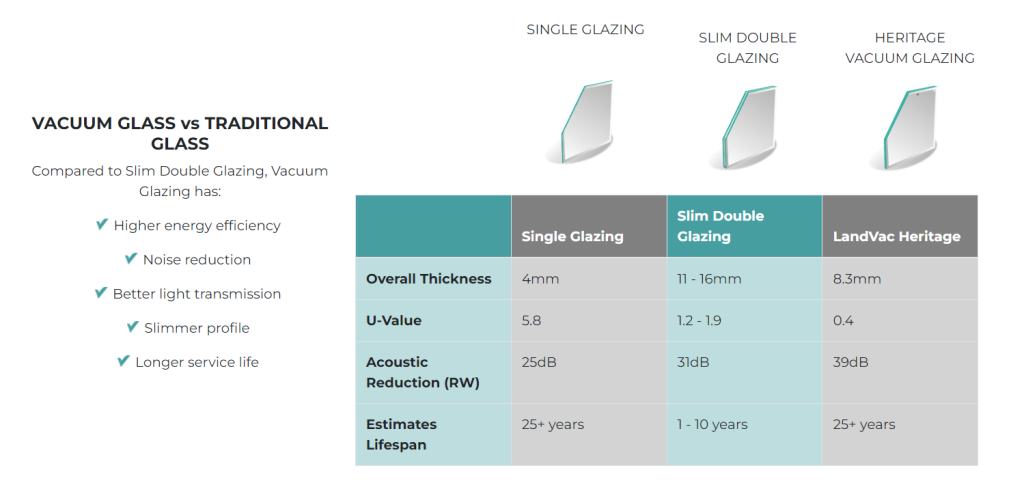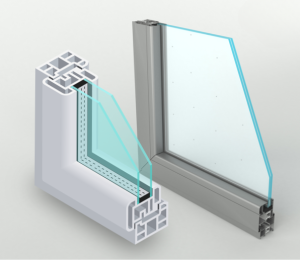Vacuum vs Slimline Double Glazing, which one do you need?
When it comes to making your period home more energy efficient, there are plenty of different ways you can make changes to help reduce your bills. One of those is by using double glazed windows. Both the vacuum and slimline versions of double glazing are designed to help keep heat in during the winter and out during the summer, while also reducing noise between your home and the outside world. With smaller cavities, they will be a closer match to the original single glazed windows that older buildings would have been fitted with originally. Which one is better? Let’s take a look!
Why do we need ultra slim double glazed windows?
Slim double glazed windows are used in the UK when upgrading Listed Buildings and those within Conservation Zones to maintain the traditional slim profile appearance of historic single-glazed timber windows. In a nation with such a rich architectural heritage, there are many homeowners seeking to restore their properties. They want a renovation approach that allows them to employ certain modern materials and techniques to enjoy a high quality of life, without jeopardising the historic quality of the property.
Restored windows can provide a number of advantages, including enhanced thermal properties, resulting in long-term cost savings, as well as improved security and soundproofing. There is a lot of demand for this empathetic restoration work. The last few years have seen the emergence of a window restoration niche that focuses on retrofitting glazing into existing frames rather than replacing the entire window.
However, in some cases, the entire windows do need replacing, and this has seen the development of Heritage Windows – classically styled windows with modern efficiency.
Obtaining planning permission
One of the problems facing owners of Listed buildings is navigating the regulatory maze of necessary building permissions that come with renovating these properties. One of the most common requirements from planning officers in restoration projects is that the new windows are as close to the original items as possible. This often means fitting single-glazed windows. As no home owner wants to fit cold windows, and standard double glazing will not pass the planning permission requirements, slim double glazed windows were seen as an ideal compromise.
What is a slimline double glazed window?
Slimline double glazing is basically standard double glazing, only much thinner.
It was created to fill the need for modern, efficient windows that mimic single glazed windows, a problem when restoring older properties. It consists of 2 panes of glass separated by a cavity filled with Argon or Krypton gas. The presence of this noble glass, which is denser than air, reduces the thermal conductivity of the windows, making them more efficient.
Slim double glazing has emerged to meet a real and important need, but there are a few key shortcomings that can cause serious problems downstream. Among these is the manufacturing process used on many windows of this type.
To provide a more authentic single-glazed appearance, some manufacturers are lowering the depth of sealant applied to allow the spacer bars to sit lower in the window to reduce the prominence of the spacer bars. The slimline product maintains sightline height within 8-10mm, ensuring compliance with many council and building regulations regarding historic window restoration. Many architects and conservation officers are suggesting this product to clients without being aware of potential complications.
Moisture penetration into the cavities between the glazing is increased in windows of this type, as well as a faster rate of gas escape from within the glazing. The longevity of window units is greatly reduced when both of these factors are accounted for – retention of gas between the glazing and moisture ingress.
What is Vacuum Glazing?
As the name suggests, vacuum glazing has a vacuum in the cavity between the two panes of glass. Not only does this make the windows extremely thermally efficient, it allows them to be much narrower that slim double glazing.
Most slim double glazed windows have a cavity thickness of 4 – 8mm (compared to 20 – 22mm for standard double glazed windows). Because a vacuum is an absence of matter, and you can’t have ‘more nothing’, then the cavity can be only 0.3mm and yet still have the same efficiency as if it were a mile wide.
It is this ultra-narrow profile that makes vacuum glazing such a great choice for renovation projects where the planning officer has specified that single glazed units should be used. The windows appear to be incredibly slim, the horrible double reflection effect that comes with standard double glazing is eliminated, and the property is much more energy efficient.
Which one should you choose?
Vacuum glass is more energy efficient than slim double glazed windows and is more likely to get passed by your local planning department. It’s also much more reliable and less prone to failure than slim units. Some slim double glazing manufacturers are being pursued through the courts for the longevity of their products.
LandVac vacuum glazing has a 15 year warranty and an expected service life of in excess of 25 years, though it’s expected to be measured in ‘generations’ rather than years.
Vacuum glass also has better soundproofing qualities than slim double glazing. Sound cannot cross the void and a typical 8.3mm thick vacuum unit achieves noise reduction performance similar to specialist acoustic units.
LandVac vacuum glass is also incredibly safe. It is the only vacuum glass available on the market which is fully toughened. This means that it’s more resilient and harder to break than typical glass, but if broken, it shatters into tiny pieces like a car windscreen for safety.
Admittedly, vacuum glazing does have higher upfront costs than slim double glazing. But in the current climate of rising energy prices, homeowners can recoup their expenditure swiftly with the energy they save from having more efficient windows. When you consider the higher maintenance costs of slim double glazing, then vacuum glazing is *ahem* the clear winner.

